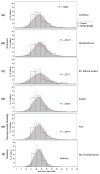Prevalence and impact of unhealthy weight in a national sample of US adolescents with autism and other learning and behavioral disabilities
- PMID: 24553796
- PMCID: PMC5328414
- DOI: 10.1007/s10995-014-1442-y
Prevalence and impact of unhealthy weight in a national sample of US adolescents with autism and other learning and behavioral disabilities
Abstract
We estimated the prevalence of obesity, overweight, and underweight among US adolescents with and without autism and other learning and behavioral developmental disabilities (DDs) and assessed the health consequences of obesity among adolescents with DDs. From the 2008 to 2010 National Health Interview Survey, we selected 9,619 adolescents ages 12-17 years. Parent respondents reported weight, height, presence of DDs and health conditions. We calculated body mass index (BMI) and defined obesity, overweight, and underweight as ≥95th, ≥85th to <95th, and <5th percentiles, respectively, using established criteria. We created mutually-exclusive DD subgroups using the following order of precedence: autism; intellectual disability; attention-deficit-hyperactivity-disorder; learning disorder/other developmental delay. We compared BMI outcomes among adolescents in each DD group versus adolescents without DDs using multivariable logistic regression. Socio-demographic factors and birthweight were included as confounders. Estimates were weighted to reflect the US population. Both obesity and underweight prevalences were higher among adolescents with than without DDs [adjusted prevalence ratios (aPR) 1.5 (1.25-1.75) and 1.5 (1.01-2.20), respectively]. Obesity was elevated among adolescents with all DD types, and was highest among the autism subgroup [aPR 2.1 (1.44-3.16)]. Adolescents with either a DD or obesity had higher prevalences of common respiratory, gastrointestinal, dermatological and neurological conditions/symptoms than nonobese adolescents without DDs. Adolescents with both DDs and obesity had the highest estimates for most conditions. Obesity is high among adolescents with autism and other DDs and poses added chronic health risks. Obesity prevention and management approaches for this vulnerable population subgroup need further consideration.
Figures


References
-
- Singh GK, Kogan MD. A 75th Anniversary Publication. Health Resources and Services Administration, Maternal and Child Health Bureau. Rockville, MD: U.S. Department of Health and Human Services; 2010. Childhood obesity in the United States, 1976–2008: Trends and current racial/ethnic, socioeconomic, and geographic disparities; pp. 1–8.
-
- Bandini LG, Curtin C, Hamad C, Tybor DJ, Must A. Prevalence of overweight in children with developmental disorders in the continuous national health and nutrition examination survey (NHANES) 1999–2002. The Journal of Pediatrics. 2005;146:738–743. - PubMed
-
- Chen AY, Kim SE, Houtrow AJ, Newacheck PW. Prevalence of obesity among children with chronic conditions. Obesity. 2009;18:210–213. - PubMed
Publication types
MeSH terms
Grants and funding
LinkOut - more resources
Full Text Sources
Other Literature Sources
Medical
Miscellaneous

